View in other NatureServe Network Field Guides
NatureServe
Montana
Utah
Wyoming
Idaho
Wisconsin
British Columbia
South Carolina
Yukon
California
New York
Glossy Pillar Snail - Cochlicopa lubrica
Other Names:
Cionella lubrica, Helix lubrica
General Description
A small shell, to about 2.5 mm diameter and 6.5 mm in height, spindle-shaped (pupiform) with a long and smooth spire bluntly-rounded at the apex, about 5 to 7 whorls. Shell coloration is translucent light brown to amber, and glossy. Aperture taller than wide, ovate and sub-vertical, lip thickened within by an opaque rib and lacks teeth (denticles); periphery rounded; umbilicus absent. Animal is darkish gray, paler on the sides (Hendricks 2012, Burke 2013). Internal anatomy is described by Pilsbry (1948) and Outeiro et al. (1990).
Diagnostic Characteristics
Combination of size (to 6.5 mm height), a glossy shell with long smooth spire that is blunt at the apex, a thickened lip, and absense of teeth in aperture, differentiates this shell from all others, including other smaller pupiform species.
Species Range
Montana Range
Range Descriptions
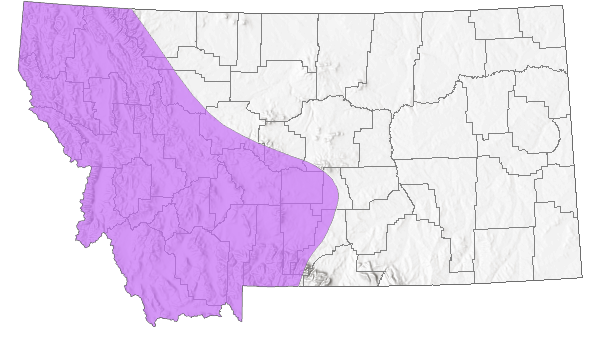
 Native
Native
Range Comments
Throughout Europe, northern Asia and Africa, and North America to Mexico (Burke 2013). In Montana, reported on both sides of the Continental Divide from five counties: Flathead, Lewis and Clark, Missoula, Ravalli, Wheatland. Elevation range is 963 to 1341 m (3160 to 4400 ft). Range in Montana poorly defined. May be relatively common locally; 17 were found at one Ravalli County site in late June (Hendricks 2012). Range in Montana still poorly documented.
Observations in Montana Natural Heritage Program Database
Number of Observations: 19
(Click on the following maps and charts to see full sized version)
Map Help and Descriptions
Relative Density
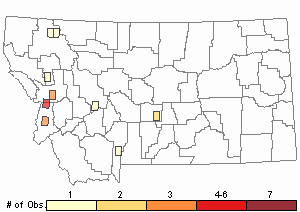
Recency
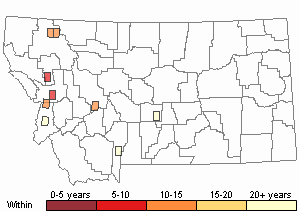
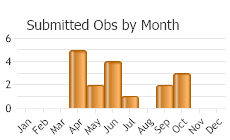
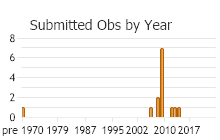
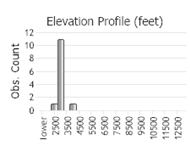 (Observations spanning multiple months or years are excluded from time charts)
(Observations spanning multiple months or years are excluded from time charts)
Habitat
Moister sites, often in disturbed areas such as gardens, residential areas, roadsides and pastures; not common in natural areas or dense forest. Canopy tree species include black cottonwood, aspen, scattered Engelmann spruce, ponderosa pine, secondary canopy species include willow and alder. Found under woody debris and in leaf litter or duff (Hendricks 2012).
Stewardship Responsibility
References
- Literature Cited AboveLegend:
 View Online Publication
View Online Publication Burke, T. E. 2013. Land snails and slugs of the Pacific Northwest. Corvallis, OR: Oregon State University Press. 344 p.
Burke, T. E. 2013. Land snails and slugs of the Pacific Northwest. Corvallis, OR: Oregon State University Press. 344 p. Hendricks, P. 2012. A Guide to the Land Snails and Slugs of Montana. A report to the U.S. Forest Service - Region 1. Montana Natural Heritage Program, Helena, MT. vii + 187 pp. plus appendices.
Hendricks, P. 2012. A Guide to the Land Snails and Slugs of Montana. A report to the U.S. Forest Service - Region 1. Montana Natural Heritage Program, Helena, MT. vii + 187 pp. plus appendices. Outeiro, A., S. Mato, I. Riballo, and T. Rodriguez. 1990. On Cochlicopa lubrica (Müller, 1774) and Cochlicopa lubricella (Porro, 1837) (Gastropoda: Pulmonata: Cochlicopidae) in the Sierra de O Courel (Lugo, NW Spain). The Veliger 33:408-415
Outeiro, A., S. Mato, I. Riballo, and T. Rodriguez. 1990. On Cochlicopa lubrica (Müller, 1774) and Cochlicopa lubricella (Porro, 1837) (Gastropoda: Pulmonata: Cochlicopidae) in the Sierra de O Courel (Lugo, NW Spain). The Veliger 33:408-415 Pilsbry, H.A. 1948. Land Mollusca of North America (north of Mexico), Volume II Part 2. The Academy of Natural Sciences of Philadelphia Monograph Number 2(2): 521-1113.
Pilsbry, H.A. 1948. Land Mollusca of North America (north of Mexico), Volume II Part 2. The Academy of Natural Sciences of Philadelphia Monograph Number 2(2): 521-1113.
- Additional ReferencesLegend:
 View Online Publication
View Online Publication
Do you know of a citation we're missing? Berry, S.S. 1916. Notes of Mollusca of central Montana. Nautilus 29:124-128.
Berry, S.S. 1916. Notes of Mollusca of central Montana. Nautilus 29:124-128. Forsyth, R.G. 2004. Land snails of British Columbia. Royal British Columbia Museum: Victoria, British Columbia, Canada. 188 pp.
Forsyth, R.G. 2004. Land snails of British Columbia. Royal British Columbia Museum: Victoria, British Columbia, Canada. 188 pp. Frest, T.J. and E.J. Johannes. 2001. An annotated checklist of Idaho land and freshwater mollusks. Journal of the Idaho Academy of Science 36(2):1-51.
Frest, T.J. and E.J. Johannes. 2001. An annotated checklist of Idaho land and freshwater mollusks. Journal of the Idaho Academy of Science 36(2):1-51. Smith, A.G. 1943. Mollusks of the Clearwater Mountains, Idaho. Proceedings of the California Academy of Sciences, fourth series, 23:537-554.
Smith, A.G. 1943. Mollusks of the Clearwater Mountains, Idaho. Proceedings of the California Academy of Sciences, fourth series, 23:537-554. Vanatta, E.G. 1914. Montana shells. Proceedings of the Academy of Natural Sciences of Philadelphia 66:367-371.
Vanatta, E.G. 1914. Montana shells. Proceedings of the Academy of Natural Sciences of Philadelphia 66:367-371.
- Web Search Engines for Articles on "Glossy Pillar Snail"
- Additional Sources of Information Related to "Snails / Slugs"





